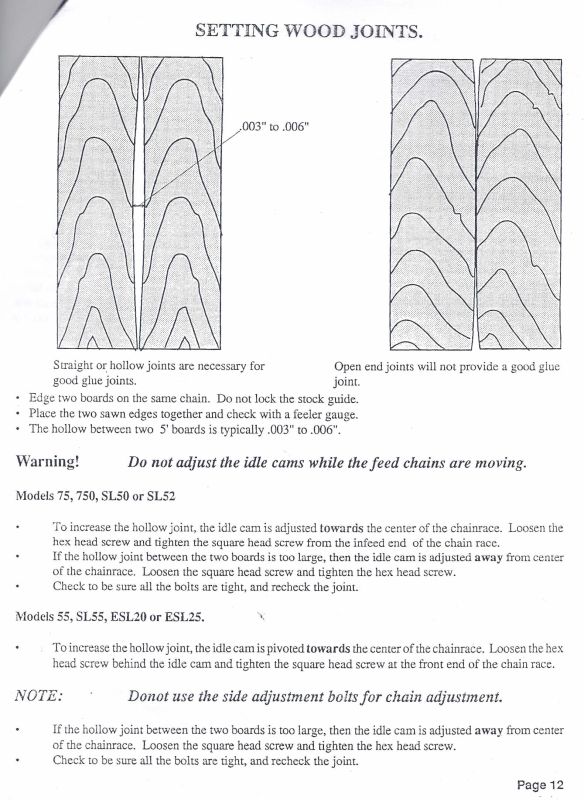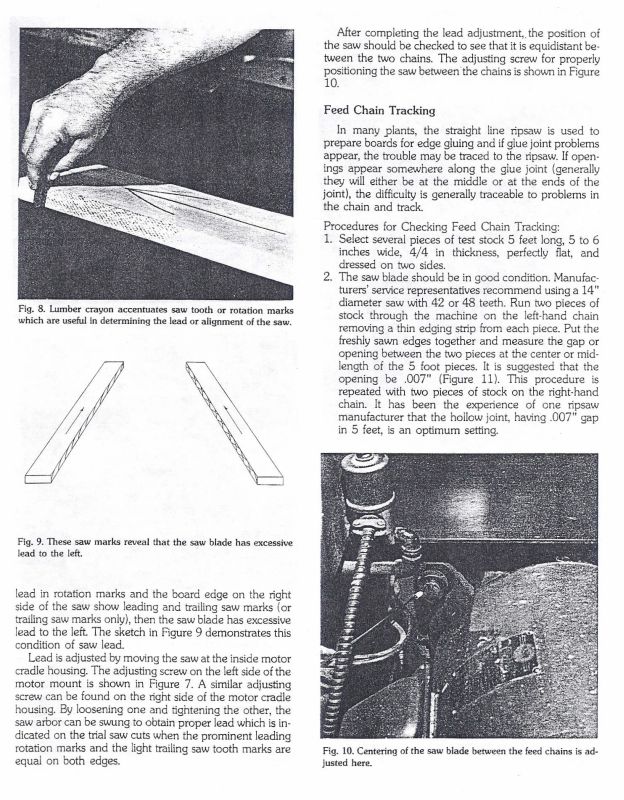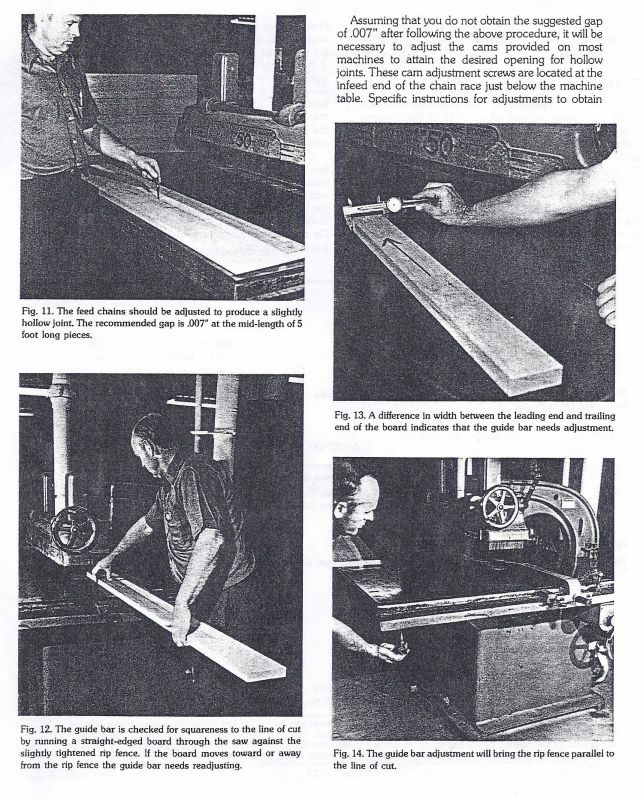Question (WOODWEB Member) :
I've been trying to learn about glue line rips on a straight line rip saw. I hope to select the right saw for my purposes considering the current marketplace. I've read every related post I found on WOODWEB and thank all of you who have shared your knowledge though there are several unanswered questions. One is whether Diehl really is the only manufacturer whose saws that can intentionally, consistently saw hollow or sprung joints. There's a lot mystery surrounding this issue. Can you set me straight? Is there some basis for the contention that either Eckstrom-Carlson or Mattison built superior machines? Is Diehl best because it has survived?
Diehl guarantees a 5' glue line rip capability on their new saws. I assume that is the maximum length of the sprung joint their saws can cut. Is that correct? I have not found instructions for setting up Diehl's saws to cut sprung joints. Neither have I found any mention of what is required to return them to cutting straight lines. Is it is feasible to rip a few boards with sprung joints for a table top then revert to cutting straight straight cuts? Does a Diehl Straight line rip saw always impart 5' of "spring" to the first 5' of its rips? How about on both sides of the blade? How is that achieved?
What about the preparation of 2' panels? Would some portion of that same 5' curvature be cut into those edges? I realize the sprung joint is just a bit deeper than hypothetical but I've been springing table top glue lines with a hand plane for the last 35 years and believe it does matter. Does a Diehl in good condition spring all joints? If you glued up a 3' wide, 2' long panel of 1/2" wide rippings would there be a pronounced bow to the outer edges?
Distributors of Chinese over-cutting SLRs claim their machines are capable of 16' glue line rips. What does that mean? Is it true just in the sense that your clamps can always bring two of their 16' rips into intimate contact? I've come across the advice to equip a SLR with a good laser. What are the characteristics of a good one? Is there anything in them to wear out? Would a ten year old laser that cost $600 new be a questionable value at $100? How does one recognize a stinker of a laser? I understand about chain diamonds not being worn to flats more than .040 across and about chain grooves and their guides not feeling worn. Can you tell anything about their condition by measuring lateral play?
Forum Responses
(Solid Wood Machining Forum)
From Contributor O:
My experience hands on is with only Diehl saws - four-five of them over the years. I have hearsay about other saws. I will say that Diehl is the only "Old Iron" that has parts and tech support as well as techs that will actually help with their products. Give them a serial number and they will provide history on the saw.
In practice, an SL 55 will produce glue line quality joints for three shifts a day for 20 years or more, with maintenance. The saw is designed to produce blanks for molders or panels by ripping off an edge, and then ripping again for width. There is a slight adjustment for hollow, but this is a one-time thing - not changed from day to day or board to board.
The saws I used had race and chains in good shape and they produced 16' long 4/4 rough blanks to be glued for width almost every day. They were perfect - no rejects and no open ends, kinks, etc. They also were not hollow. There is no reason for them to be hollow - if they were, we would adjust the saw so they were as straight as we could make it.
The notion of a hollow joint is outdated in my opinion. Two straight edges coming together will glue just fine. An SLR is only for production; for the small shop, a joiner is used to produce good edges for gluing. A patternmaker's joiner (like Northfield) can even be adjusted to make the joints hollow if one wants. I will ask why you feel the hollow joint is a must have characteristic. Two straight edges are what is required unless you require a certain curvature to the edge. Then a joiner, of CNC or hand plane is called for.
A ripped edge is satisfactory for millwork glue for width, but a small furniture maker producing small quantities would want the control a joiner gives. A ripsaw will eat a certain amount of material. If miss-fed, it still goes through the saw, and boards can be ruined. Skill must be acquired, usually through two of three units of 4/4, edging for molder blanks. One would certainly not send that rare 8/4 piece of curly Bubinga through a ripsaw and hope for the best. The laser is used for aligning the wood with the cut line in that the laser line represents the cutline. A narrower and brighter beam is preferred, especially with long lumber. It needs to be positioned so that it is bright on the wood at 18' or further. Calibrate it accurately, as the saw will not 'cut right' if the laser is not aligned.
Otherwise, we wouldn’t see “Mattison style” ripaws with a single chain or gang ripsaws for that matter, ripping glue-lines for panels. I might be convinced, (with concrete empirical data) that the hollow-joint set-up is better for gluing panels at or under a given length, but I question whether it actually hinders gluing panel lengths longer than the ideal set-up length, hence I hypothesize that it may actually be a poorer set-up if the saw is to be used to rip a variety of different lengths. In my mind the straight-line set-up is a better overall set-up because it minimizes the variables as well as minimizing wear forces etc. on the saw and its components. I am sure there are some folks out there that can add to this debate and would love to hear from them, but, for what it is worth you have my opinion based upon over 15 years of practical experiences.



Festool's lack of documentation really chaps my cheeks. I'm not especially stupid but I've never figured out what some of Festool's little parts are for. The worst of that is I'm missing out on some of the capabilities. Without that understanding those parts ought to be in a coffee can in the back room rather than a in a "sustainer", the $100 plastic box that came free with the saw. I've used the saw infrequently because it is a pain to take out, set up and put away for one cut. That cut, however, will be as good as from any of my stationary machines. Trying to use several short sections of Festool's guide track are also a pain with their easily-lost proprietary set screws. Also, multiple splices in a guide rail simply cost accuracy. Having vented, I'm beginning to understand how that could work: a shop-built straightening bench and one long section of track.